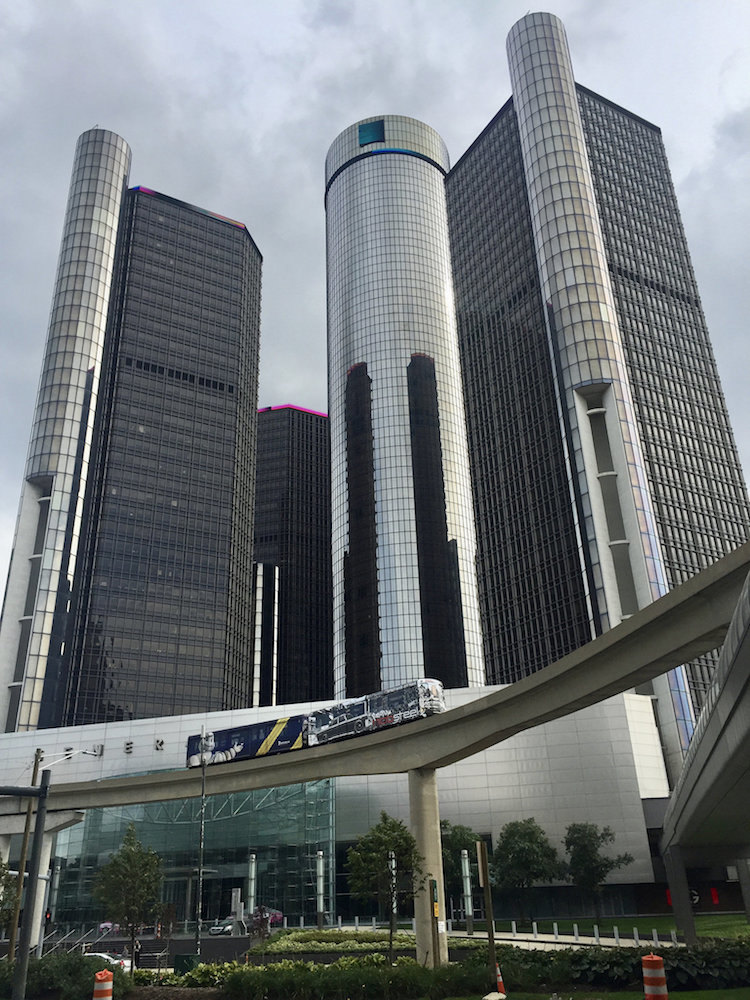The Downtown People Mover
How Cleveland Returned a $41-Million Federal Grant

Envision walking out of Tower City Center, ascending an escalator, and boarding a driverless train that whisks you around downtown fifteen feet above the streets below. The monorail, dubbed the Downtown People Mover, represented progress and modernity. In 1976, Mayor Ralph Perk submitted Cleveland’s Downtown People Mover proposal to the federal government. The DPM proposal portrayed Cleveland as the ideal city for a monorail.
The various attempts at developing an effective system to circulate people through downtown led to the development of the Downtown People Mover. In 1969, the Urban Mass Transit Administration (UMTA), created five years earlier amid a flurry of Great Society legislation, funded a People Mover project for Morgantown, West Virginia. The people mover successfully transported students and faculty throughout the West Virginia University campus, avoiding the traffic congestion in the city, but the concept was slow to progress to the next level. Accordingly, the federal government set aside $220 million to test the abilities of People Movers as downtown transportation in the spring of 1976 and held a national competition in which a number of cities submitted proposals.
The Plain Dealer characterized the unveiling of the winning cities as being as “suspenseful as an Academy Award show.” U.S. Secretary of Transportation William T. Coleman announced the grant recipients at a news conference by revealing downtown maps of the winners. Cleveland, Houston, Los Angeles and St. Paul won portions of the federal grant, while Detroit won a portion of funds from an earlier people mover grant.
Downtown transit circulation was an important concern in Cleveland as in other U.S. cities, particularly in the second half of the twentieth century. In the 1950s the Cleveland Transit System (predecessor of today’s RTA) had twice failed to achieve a downtown circulator subway to serve as the hub for a revamped rapid transit system serving the metropolitan area. Cleveland;s downtown consisted of dispersed retail locations, government centers, and office buildings, which the DPM planned to connect with its 2.2 mile loop, elevated fifteen feet above Cleveland’s streets.
Many opposed the construction of the DPM, including Thomas E. Bier, then an assistant professor at the Institute of Urban Studies at Cleveland State University. The proposed route would have run along Euclid Avenue, stopping at East 6th, East 9th, and East 13th Streets. At lunchtime, the area of Euclid Avenue between Public Square and East 9th brought together a variety of people in regard to class, race, and age. Bier reasoned that building the DPM fifteen feet above street level would further promote separation of the affluent, largely white pedestrians from less affluent, particularly African Americans. The lower-income shoppers of Euclid Avenue between Public Square and East 9th would have had little use for the DPM, therefore separating them from the higher income shoppers traveling further down Euclid Avenue to reach Halle’s and other upscale retailers.
Norman Krumholz, the City Planning Director in Cleveland at the time, also opposed the DPM. Krumholz concluded that the DPM conflicted with the transportation needs of 87 percent of RTA bus riders. The DPM’s free fare would undermine the twenty-five-cent fare that RTA had promised to uphold for three years. Armed with the information from Krumholz, Cuyahoga County Commissioners Robert Sweeny and George Voinovich also opposed the building of the DPM calling it “unnecessary . . . and the potential ruination of downtown.” Sweeney and Voinovich requested that Secretary of Transportation Brock Adams take back Cleveland’s Downtown People Mover grant, a premonition of what the future held.
Much like the failed Cleveland subway system, Cleveland did not build a DPM. Elected mayor in 1977, Dennis Kucinich requested that U.S. Transportation Secretary Brock Adams withdraw Cleveland’s application for the federal DPM grant. Richard Page, the director of UMTA, expressed his surprise. The UMTA had never been turned down for a federal grant by a mayor or city government before. Kucinich stated three objections to the DPM. First, the DPM violated an agreement with the RTA against such systems. Second, Kucinich expected the cost of the DPM to exceed its estimate. Finally, Cleveland’s existing transit system would be negatively impacted by the DPM.
Both Detroit’s DPM and the Morgantown People Mover exceeded their initial budgets by millions, legitimizing Kucinich’s fear of cost overruns. Cleveland’s DPM was expected to serve 46,500 riders per day. Morgantown’s People Mover transports 10,000 people per day. Detroit’s DPM transports the same number, even though it was estimated to move 55,000 passengers per day. Would the Downtown People Mover have proved popular enough to move 46,500 Clevelanders per day through downtown? Cleveland will never know, but if Detroit’s DPM is any indication, the answer is unlikely.
Images










